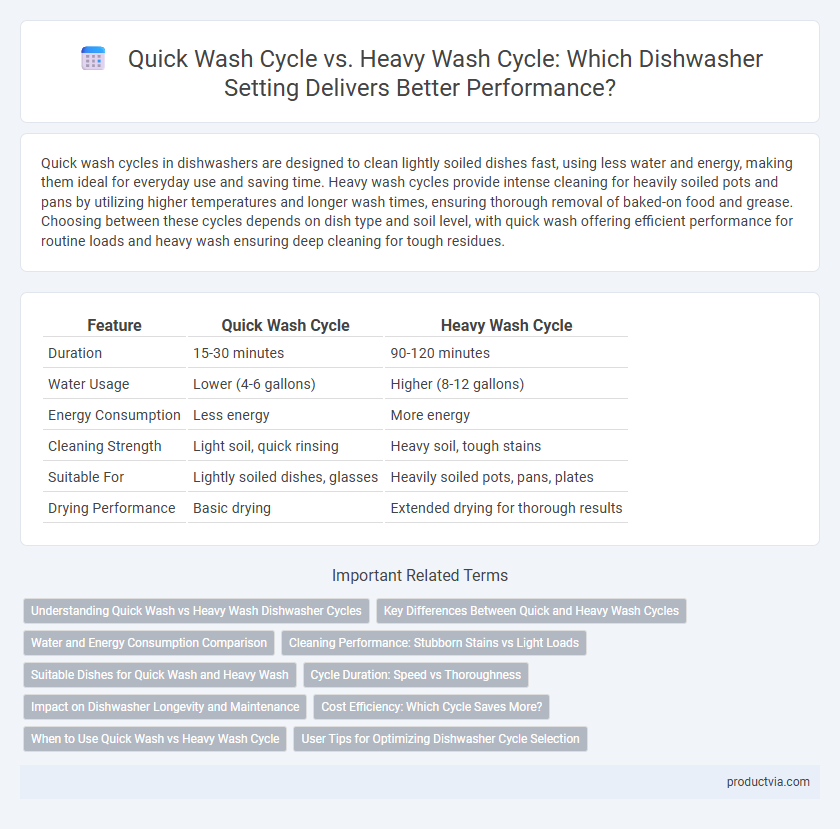Quick wash cycles in dishwashers are designed to clean lightly soiled dishes fast, using less water and energy, making them ideal for everyday use and saving time. Heavy wash cycles provide intense cleaning for heavily soiled pots and pans by utilizing higher temperatures and longer wash times, ensuring thorough removal of baked-on food and grease. Choosing between these cycles depends on dish type and soil level, with quick wash offering efficient performance for routine loads and heavy wash ensuring deep cleaning for tough residues.
Table of Comparison
| Feature | Quick Wash Cycle | Heavy Wash Cycle |
|---|---|---|
| Duration | 15-30 minutes | 90-120 minutes |
| Water Usage | Lower (4-6 gallons) | Higher (8-12 gallons) |
| Energy Consumption | Less energy | More energy |
| Cleaning Strength | Light soil, quick rinsing | Heavy soil, tough stains |
| Suitable For | Lightly soiled dishes, glasses | Heavily soiled pots, pans, plates |
| Drying Performance | Basic drying | Extended drying for thorough results |
Understanding Quick Wash vs Heavy Wash Dishwasher Cycles
Quick wash dishwasher cycles typically last 20-30 minutes and use less water and energy, making them ideal for lightly soiled dishes. Heavy wash cycles run 90 minutes or longer, applying higher water temperature and pressure to effectively remove stubborn food residues and grease. Choosing the appropriate cycle improves cleaning performance, energy efficiency, and prolongs dishwasher lifespan.
Key Differences Between Quick and Heavy Wash Cycles
The quick wash cycle in dishwashers typically completes in 20-30 minutes, using lower water temperature and pressure to clean lightly soiled dishes efficiently. The heavy wash cycle runs for 90 minutes or more, employing higher temperatures, stronger water jets, and extended soaking to remove stubborn food residues and grease from heavily soiled pots and pans. Quick wash cycles prioritize energy and water savings while heavy wash ensures thorough cleaning performance under demanding conditions.
Water and Energy Consumption Comparison
A quick wash cycle in a dishwasher typically consumes 3 to 5 gallons of water and uses around 0.8 to 1.2 kWh of energy, optimizing for lower resource consumption and shorter run times. In contrast, a heavy wash cycle uses approximately 6 to 8 gallons of water and consumes 1.5 to 2.0 kWh of energy, designed to tackle heavily soiled dishes with extended washing phases. Choosing between these cycles impacts overall dishwasher performance by balancing water efficiency and energy use according to cleaning intensity requirements.
Cleaning Performance: Stubborn Stains vs Light Loads
The quick wash cycle is designed for light loads and moderately soiled dishes, providing efficient cleaning within a shorter time frame by using higher water pressure and temperature bursts. In contrast, the heavy wash cycle excels at removing stubborn stains and baked-on food residues through extended wash times, increased water temperature, and powerful jets, ensuring thorough cleaning for heavily soiled cookware. Selecting the appropriate cycle optimizes dishwasher performance by balancing cleaning intensity and energy consumption based on the degree of soil on dishes.
Suitable Dishes for Quick Wash and Heavy Wash
The quick wash cycle in dishwashers is ideal for lightly soiled dishes, such as glasses, cups, and utensils, requiring less water and energy for faster cleaning. The heavy wash cycle targets heavily soiled items like pots, pans, and baked-on food residue, using higher temperatures and longer wash times to ensure thorough cleaning. Choosing the appropriate cycle enhances dishwasher performance by balancing cleaning efficiency with energy consumption.
Cycle Duration: Speed vs Thoroughness
Quick wash cycle typically lasts between 20 to 40 minutes, prioritizing speed for lightly soiled dishes, while heavy wash cycles extend from 90 to 150 minutes to ensure deep cleaning of heavily soiled or baked-on residues. The shorter duration of the quick wash consumes less water and energy but may sacrifice thoroughness, making it best suited for everyday cleaning needs. In contrast, heavy wash cycles optimize dishwasher performance by employing higher temperatures and longer wash periods, ensuring comprehensive removal of stubborn food particles and sanitization.
Impact on Dishwasher Longevity and Maintenance
The quick wash cycle uses less water and energy by operating for a shorter duration, reducing wear on dishwasher components and potentially extending the appliance's lifespan. In contrast, the heavy wash cycle puts more strain on the motor and heating elements due to longer runtimes and higher temperatures needed for tough stains, which can accelerate component wear and increase maintenance needs. Choosing the appropriate cycle based on soil level balances cleaning efficiency with dishwasher durability and upkeep frequency.
Cost Efficiency: Which Cycle Saves More?
Quick wash cycles consume less water and energy compared to heavy wash cycles, making them more cost-efficient for lightly soiled dishes. Heavy wash cycles, while using more resources, ensure thorough cleaning of heavily soiled pots and pans, potentially reducing the need for re-washing. Choosing the appropriate cycle based on soil level optimizes overall dishwasher performance and minimizes utility costs.
When to Use Quick Wash vs Heavy Wash Cycle
Quick wash cycles are ideal for lightly soiled dishes and small loads, providing efficient cleaning in less than 30 minutes while conserving water and energy. Heavy wash cycles are designed for heavily soiled pots, pans, and casserole dishes, using higher water temperatures and longer wash times to remove baked-on food and grease effectively. Choosing the right cycle depends on the soil level and type of dishes, ensuring optimal dishwasher performance and cleanliness.
User Tips for Optimizing Dishwasher Cycle Selection
Selecting the quick wash cycle saves time and energy by using lower water temperatures and shorter duration, ideal for lightly soiled dishes or everyday meals. The heavy wash cycle operates at higher temperatures with extended wash times, effectively removing tough food residues and sanitizing heavily soiled cookware. Users should match cycle selection to the soil level and dish type to optimize cleaning performance and energy efficiency, ensuring delicate items are not exposed to harsh conditions while heavily soiled utensils receive thorough cleaning.
Quick wash cycle vs heavy wash cycle for dishwasher performance Infographic

 productvia.com
productvia.com